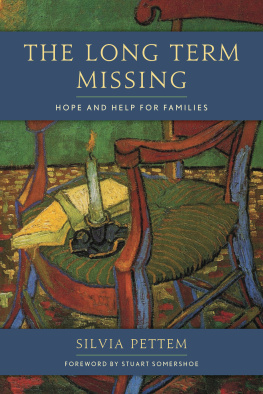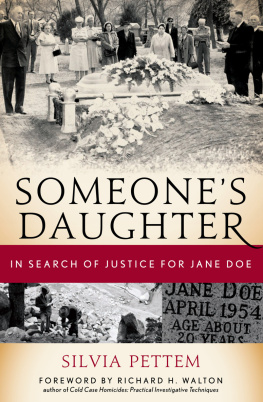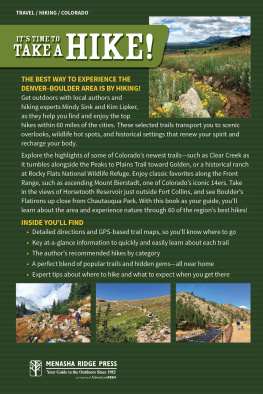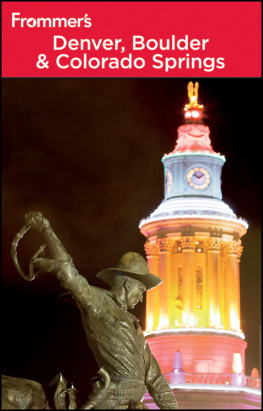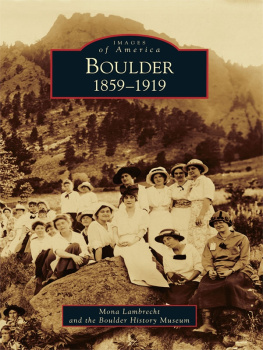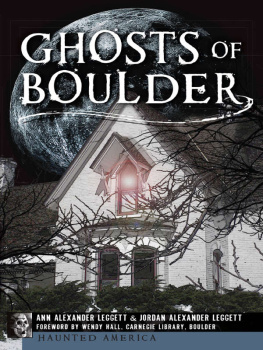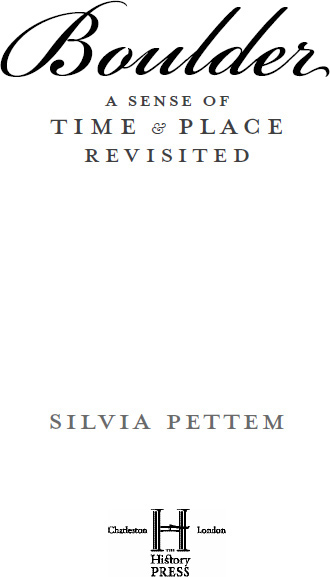Published by The History Press
Charleston, SC 29403
www.historypress.net
Copyright 2010 by Silvia Pettem
All rights reserved
Front cover: Unidentified man looking down on Boulder from Mount Sanitas. Courtesy of the Carnegie Branch Library for Local History, Boulder Historical Society Collection.
First published 2010
e-book edition 2011
ISBN 978.1.61423.260.5
Library of Congress Cataloging-in-Publication Data
Pettem, Silvia.
Boulder : a sense of time and place revisited / Silvia Pettem.
p. cm.
Includes index.
print edition ISBN 978-1-59629-974-0
1. Boulder (Colo.)--History. 2. Boulder (Colo.)--Social life and customs. 3. Boulder (Colo.)--Biography. 4. Historic buildings--Colorado--Boulder. 5. Boulder (Colo.)--Buildings, structures, etc. I. Title.
F784.B66P476 2010
978.863--dc22
2010026223
Notice: The information in this book is true and complete to the best of our knowledge. It is offered without guarantee on the part of the author or The History Press. The author and The History Press disclaim all liability in connection with the use of this book.
All rights reserved. No part of this book may be reproduced or transmitted in any form whatsoever without prior written permission from the publisher except in the case of brief quotations embodied in critical articles and reviews.
Contents
Acknowledgements
Many people contributed to this book, but I would like to thank those who helped the mostmy editors at the Daily Camera, the librarians at the Carnegie Branch Library for Local History and the trustees of the Boulder History Museum.
Boulder: A Sense of Time & Place Revisited is a collection of sixty history columns first published (and reprinted with permission) by the Camera during the years 19982010. My first editor was Maria Cote, followed by Jay Dedrick, Lisa Marshall, Sandra Fish, Greg Glasgow, Erika Stutzman, Cindy Sutter and Dave Burdick. Special thanks also go to former Camera librarian Carol Taylor, past executive editor Thad Keyes and present executive editor Kevin Kaufman.
Wendy Hall, Mary Jo Reitsema and Marti Anderson, of the Carnegie Branch Library for Local History in Boulder, offered invaluable assistance in helping me select and procure photographs that best illustrate the stories.
Im grateful, too, to Nancy Geyer, executive director and CEO of the Boulder History Museum, for the museums partnership with this project, which allowed me the use of several of the museums photographs.
Part I
Pre-1900
B LEAK H OLIDAY I NSPIRED C HRISTMAS S PIRIT
When early Boulder settler Morse Coffin wrote his reminiscences of Christmas in Boulder in 1859, he called himself a sort of mild crank on the subject of hospitality. To him, the holiday had meant kindness to ones fellow man, particularly when it came to offering food. But Coffins first Christmas in Boulder wasnt what he had in mind.
The Colorado gold rush got underway in the spring of 1859. In May of that year, twenty-three-year-old Coffin and two friends left the farmlands of Illinois to seek their fortune in the West. They ended their journey two months later in the small settlement of Boulder.
The countys first wheat crop was yet to come, and the price of flour was high. Coffin found a job in a sawmill, which paid for flour, sugar, coffee and other staples hauled from the states. He claimed that his sole purpose in working at the mill was to make grub for the winter.
Coffin and a friend, Jim, lived in a shack on high tableland in the vicinity of todays Table Mesa. A few days before Christmas, when the mens provisions were low, Jim went to Denver for supplies. Coffin was left to fend for himself.
On Christmas morning, being alone, the ground mostly bare so tramping was easy and the weather fine, I decided to take a hunt and try for some meat, wrote Coffin. With two small biscuits in [my] pocket, also matches and a trifle of salt, I started to climb the high mountain directly to the west.

The cooking area of this Boulder County miners cabin was typical of that used by Morse Coffin and others in 1859. Courtesy of the author.
After a discouraging day, Coffin wandered down to the collection of log cabins that made up Boulder. Jim hadnt arrived, so Coffin visited a Mr. P. Right in front of him, Mr. P. took a loaf of bread out of his Dutch oven and began to eat.
He sat at his table and ate it without one word of invitation to me, wrote Coffin. To say I was disgusted, hurt, and angry is putting it mildly. There was no place at that time where meals were sold. Even if there had been, all of the partners gold dust had gone to Denver with Jim.
Coffin then went to another Boulder cabin, where he had stored a gun and an overcoat. In the company of more friends, he spread out an oilcloth, propped his boots up as a pillow and prepared to spend the night.
About the time I was fixing my bed, my three friends took their nice brown biscuits from the skillet and seated themselves to an appetizing evening meal, he stated. Like the loaf at the other place, the biscuits looked good to me, but I was to have neer one of them.
Neither was Coffin offered anything to eat the next morning. He went home and had to wait until the evening, when Jim returned from Denver with the grub.
In his writings, Coffin stated that he had decided on that Christmas Day that no one would ever come to him and say, I was hungered and ye gave me no meat, I was thirsty and ye gave me no drink, I was a stranger and ye took me not in.
B OULDERS E ARLY S ETTLERS W ERE A VID F RUIT G ROWERS
Marinus Smith arrived in Boulder in June 1859 and established a mail service. Before long, however, he turned his attention to raising fruits and vegetables. When asked if he would live to see the trees he was planting bear fruit, his reply was, Old men plant trees, young men cant wait.
Boulders settlers came with a variety of work skills, but several of the early residents gave up their previous occupations for fruit farming. Instead of continuing the jobs they had in the East or making careers out of mining, they tended orchards and fruit farms within todays city limits of Boulder. The fruit trees in bloom in the city today are annual reminders of the citys long history of horticulture.
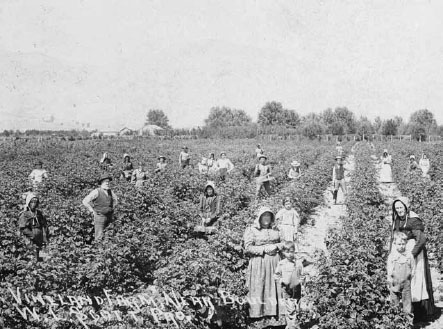
Vineland Farm was one of several fruit farms within todays city limits of Boulder. Carnegie Branch Library for Local History, Boulder Historical Society Collection.
Smith lived at Sixteenth and Grove Streets. Within a few years, the gardens that surrounded his home were described by a newspaper reporter as a wild paradise of shrubbery, fruit and shade trees. Because of his impressive rhubarb crop, he was given the nickname Pie Plant Smith. Marine Street was named in his honor.
Another settler who came to Boulder County in 1859 was British immigrant John Brierley. He tried his hand at gold mining in Gold Hill and Ward until 1865, when he decided hed rather raise and sell fruit and flowers in Boulder. He also operated a cider mill.


